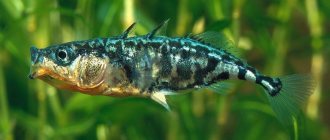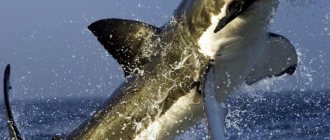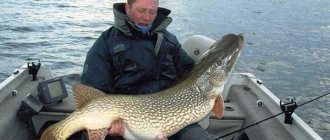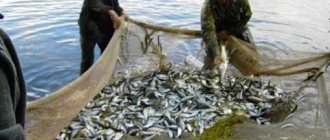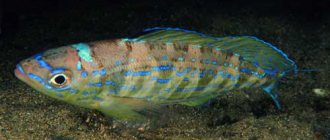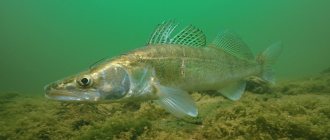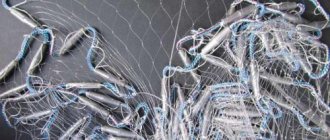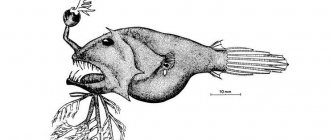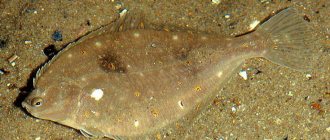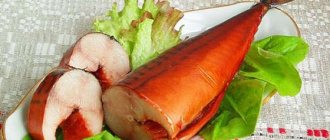Varieties
Red fish is represented by the following valuable species:
- Salmonidae, which traditionally includes salmon and trout. Any representatives of the Salmon family are called this way. But this is a collective image, since the family includes a large number of species: whale, sockeye salmon, pink salmon, whitefish, grayling and others.
- White salmon (pink), which are found on sale and are rare: taimen, white fish, nelma, coho salmon.
- Sturgeon, among which the most famous are sturgeon, stellate sturgeon, and sterlet. Their meat color is white, but sturgeon are traditionally classified as red fish for their excellent taste and high nutritional value.
For your information: The fishing of some species of red fish is limited, since their numbers are constantly falling due to barbaric fishing in large quantities. Some species living in the seas and lakes of Russia are listed in the Red Book.
Subfamily Salmonidae
The classification of the subfamily from the order Salmonidae includes seven genera. Distinctive features are a developed jaw with sharp teeth and the size of the body covered with small scales.
Brown trout
The average dimensions common to all species are 30-70 cm in length and weight up to 5 kg. Rounded dark back. Light gray oval body with shiny scales, covered with black specks. The lower jaw is pushed forward.

All forms have significant commercial value and are artificially bred. The average cost for 1 kg of red fish meat is 450 rubles.
The classification includes the following subspecies:
- Caspian trout, the largest fish of the salmon family. Weight reaches 7 kg, length 1 meter. Some representatives weigh up to 50 kg. The noble fish is listed in the Red Book.
- Black Sea trout, gaining weight in the sea, reaches a length of 50 cm. Brook trout grows up to 25 cm.
- Cis-Caucasian trout are gray-green in color with colored spots. Weight up to 500 g. Lives only in clean and cold water. Classified as an endangered species.
- Eisenam trout. They are a species of salmon fish that live in a limited area. They don't sell it en masse. There are large forms up to 1 meter long.
Atlantic salmon
Fish of the salmon family grow up to 1.5 m in length and weigh up to 40 kg. Spotted bodies with silvery scales and white belly. Lake salmon are in danger of extinction. Red meat and salmon caviar are high in the ranking of gourmet foods. Price on average from 750 rubles.
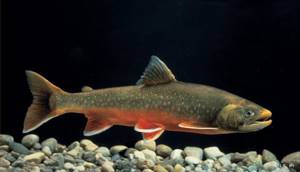
Adriatic trout
It lives in fast-flowing rivers and stays at depth. Grows up to 70 cm.
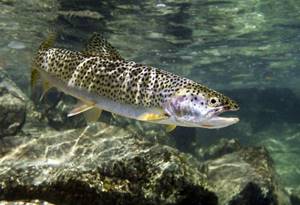
Italian trout
The fish lives in an Italian lake. The average length is 35 cm. It leads a bottom-dwelling lifestyle. Trout is listed in the Red Book.
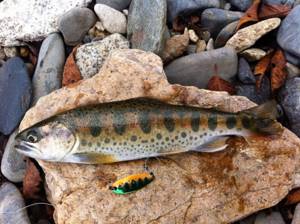
Marbled trout
Fish of the salmon family, widespread within the range of Italian, Bosnian, and Montenegrin rivers. They grow up to 70 cm in length. A distinctive feature is the large head. The color is gray-green or silver. The photo shows that the brown stripes on the body create a characteristic pattern. The meat is valued for its unique taste and tenderness. On sale in the regions where they live.
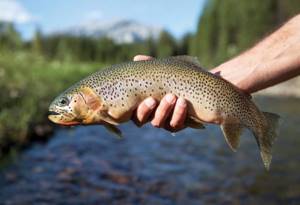
Flathead trout
Salmon species reach a length of 50 cm. They hunt bottom. Individuals are at risk of extinction and have protected status. Fishing is prohibited.
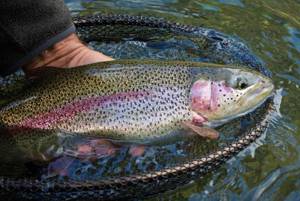
Ohrid trout
Found only in Lake Ohrid and its tributaries. The fish, similar to rainbow trout, grows up to 70 cm. The long body is covered with silvery scales with colored specks. Available in the region where it lives.
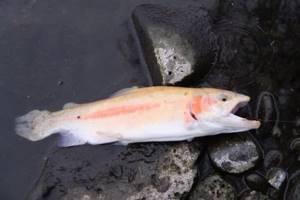
Sevan trout
Lives in the Armenian Lake Sevan. There is a walk-through form. Large specimens reach 90 cm and weigh up to 17 kg. The price for 1 kg starts from 750 rubles.
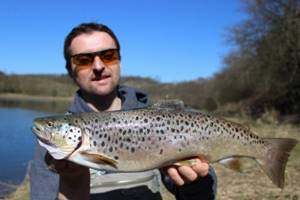
Char
All species are valuable commercial fish, containing minerals and having high taste. The representatives are large, up to 90 cm long, and live in cold waters. The lower price level is 300 rubles. The list of representatives includes:
- Arctic. The body is gray with a dark blue back, covered with spots. Color changes during the breeding season.
- White. Found in Far Eastern fresh water bodies. The color is light shades of green or brown, with small spots. The snout is short, the cavity is green.
- Boganidsky. The content of polyunsaturated fatty acids is higher than in other marine fish. “Charr grows slowly, so fishing is legally limited.”
- Lake char. The largest group among the loaches. The maximum size recorded was 33 kg, 1.5 m in length.
- Chukotka. Far Eastern specimens with a cylindrical body of silvery-white color and red fins.
- Yakut. Individuals with a dark color and stripes on the sides. Has a narrow body.
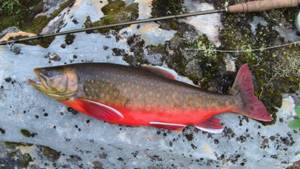
American palia
Included in the species of salmon fish resettled in natural reservoirs. Palia has a rounded body. Brown back with light speckles. The size exceeds 30 cm. It is in demand in cooking. The cost is about 400 rubles.

Kunja
Dimensions up to 60 cm, weight up to 3 kg. Refers to the commercial species of migratory char. You can buy white kunja meat for a price starting from 400 rubles.
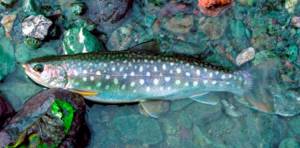
Malma
Salmon fish are up to 75 cm long and gain weight up to 3.5 kg. They swim in the northern waters of the Pacific Ocean.
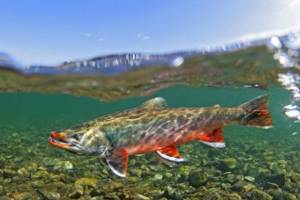
Neiva
Lake fish with a long body and silvery color. During the spawning period, it acquires a yellow or red-brown color with crimson spots. Reaches a size of 40 cm in length. Has no commercial significance.
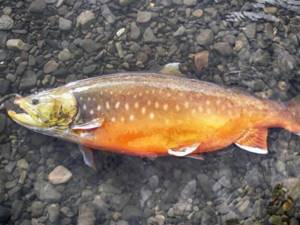
Svetovidova's longfinned palia
Small individuals up to 33 cm, listed in the Red Book. They have a short snout with a protruding lower jaw and long teeth. The body is dark gray with a golden tint.
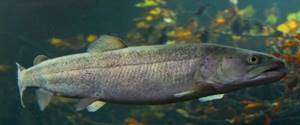
Lenok
There are river and lake forms. They have a round body with small scales. The color camouflages the salmon fish in its habitat. Lenok grows up to 70 cm weighing up to 6 kg. Refers to sport fishing objects.
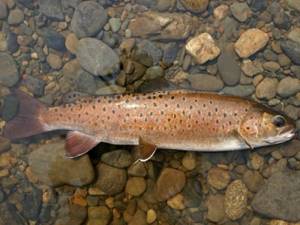
Sakhalin taimen
Individuals are large in size, growing up to 2 m, weighing up to 24 kg. Distinctive features are large scales. Taimen is included in the Red Book.
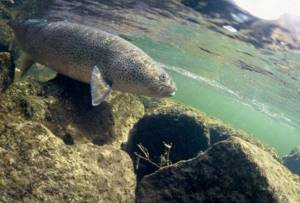
Pink salmon
Saltwater fish live in cold ocean waters. Distinctive features of the individual are the absence of teeth on the tongue and a white mouth. Commercial fish, reaches a weight of 2 kg. The color is silver with a dark blue or greenish back. Price from 250 rubles.
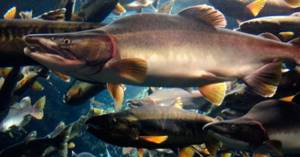
Chum salmon
Large individuals reach 1 meter in length, weighing up to 16 kg. Lives in Pacific waters. The body is light gray with dark fins. In second place after pink salmon as a mass-sold fish, with dietary meat and caviar, costing from 450 rubles. Find out how chum salmon differs from pink salmon.
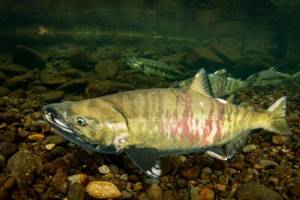
Coho salmon
The body is covered with bright silvery scales, distinguishing it from other species. Grows up to 108 cm with a weight of up to 15 kg. The meat has a healthy composition and excellent taste, increasing its commercial value. Cost from 460 rubles.
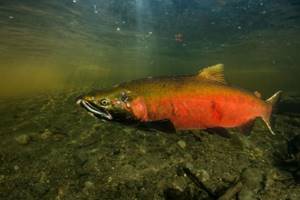
Clark's Salmon
Has red or orange lines along the lower jaw. The body is gray or yellow-green. Grows up to 75 cm. Popular for fishermen.
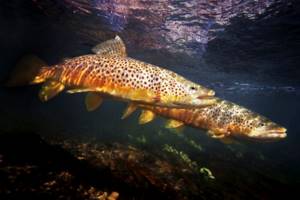
Mexican golden trout
Freshwater salmon with a golden color. Fishing rules have been established.
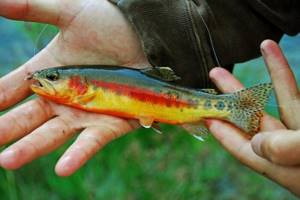
Red salmon
A fish with a red body during the breeding season and a large jaw. Grows up to 80 cm and weighs from 1.5 kg. “An interesting fact: the brightly colored fillet is colored by carotenes from crustaceans that are part of the predator’s diet.” Sockeye salmon contains a large amount of fat. Price from 650 rubles.
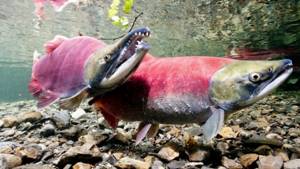
Rainbow trout
The coloring corresponds to the habitat, with a longitudinal line of bright color. Size up to 50 cm, weight up to 1.5 kg. Artificially bred, the meat contains easily digestible protein. Sold in stores at a price of 800 rubles.
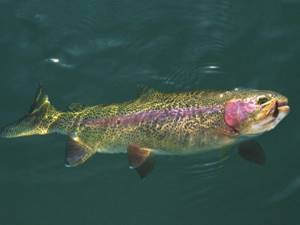
Sima
Lives in coastal Pacific waters. Size up to 80 cm and weight up to 10 kg. The Sim's walk-through form is larger. Bred in fish factories. The oval body is covered with black spots. The cost is on average 500 rubles.
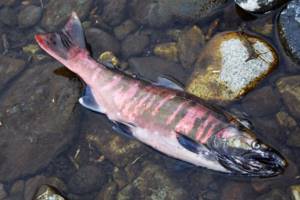
Trout Gil
It has a yellow body with spots, up to 50 cm long. Sport fishing is permitted with restrictions.
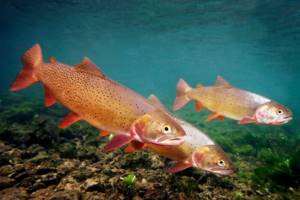
Chinook
Representatives differ in length 90 cm. Black spots cover the entire body with fins. The gums on the lower jaw are black. Commercial fishing for Chinook salmon is prohibited. It has high taste qualities.
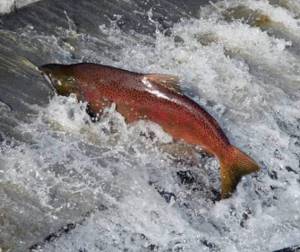
Taimen
The fish has an elongated body, with dark spots. The head is pressed from above. Wide jaw with curved teeth. The color is dull gray or green. The taimen genus includes individuals up to 2 m long and weighing up to 80 kg. They are a valuable fish and fishing is prohibited. The name is taken from its habitat. The list includes:
- Danube
- Korean
- Sichuan
- The common species lives in cold fresh water bodies from the Urals to the Far East.
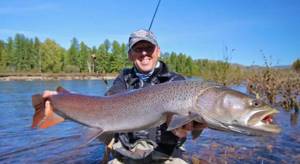
What are the benefits of a seafood product?
There are few people who would not appreciate the taste of red fish. But besides the taste, the benefits should also be appreciated.
The seafood delicacy contains:
- a whole complex of vitamins: A, D, E, P, group B, which are indispensable in metabolic processes and each has a specific role;
- “mineral cocktail”, which contains selenium or the element of longevity and iodine, necessary for the endocrine system; the role of other mineral components is no less significant;
- Omega-3 polyunsaturated fatty acids, which is an important component for our body.
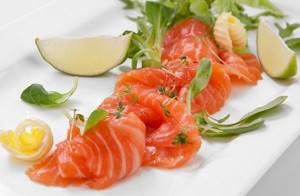
Omega-3 fatty acids give elasticity to blood vessels, nourish nerve cells, helping the nervous system cope with stress, and maintain the necessary cholesterol level.
This remedy is preventive and stops the development of many vascular and heart diseases, and prevents cancer problems. The health of bone, joint, and muscle tissue is ensured in combination with other substances by Omega-3 fatty acids.
For your information: People who have red fish in their daily menu do not suffer from hypertension so often; they are free from cancer. And if you add to this excellent memory, good mood and a stress-free life, then its need for diet is obvious.
Which varieties are most valued?
Among the noble delicacies are salmon (salmon) and trout. The meat of red fish is pink, sometimes with orange hues. In salmon it is bright, saturated colors, in trout it has a lighter shade. If you include such fish in your menu twice a week, your body will receive invaluable benefits.
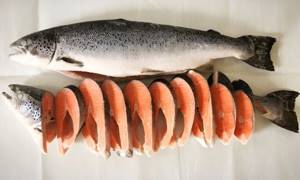
The effect will be “obvious”, since the components from the delicious product create an impeccable appearance, affecting the condition of the skin, hair, and nails.
Recommendations from nutritionists for losing weight
Red fish does not contain carbohydrates, so it is suitable for dietary nutrition. Despite the high concentration of fats, the product helps to lose excess weight because:
- speeds up metabolism;
- eliminates bad cholesterol;
- removes toxins from the body;
- improves the functioning of the digestive system;
- reduces the likelihood of developing pathologies associated with obesity.
It is better to choose varieties with the lowest calorie content. Their list includes:
- trout;
- sterlet;
- chum salmon;
- pink salmon;
- coho salmon
The fattest species are salmon, thorn, sturgeon and stellate sturgeon. To lose pounds, you need to consider more than just calories. There will be no harm even from the most nutritious fish, if it is prepared correctly. During the diet, dishes should be steamed, boiled or baked with vegetables. Use 2 times a week, 150 g.
Salted fish should be completely avoided. It retains fluid in the body, which disrupts metabolism and causes the formation of edema.

Salmon - Atlantic or lake salmon
Salmon has a delicate taste and simply melts in your mouth. There are a great variety of dishes created from it. But the most delicious option is to bake the fish in foil or cook it lightly salted. When baking, you cannot overdry it, otherwise the dish will lose its taste and the meat will lose its tenderness. Therefore, chefs advise cooking the delicacy at +80 C instead of +180 C, so that the meat retains its best qualities.
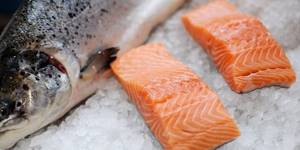
A representative of salmon is quite high in calories - 100 g contains from 140 to 220 kcal. The combination of Omega-3 and Omega-6 fatty acids in salmon is simply ideal.
Only flaxseed and walnuts have a similar ratio. The fats contained in red fish will not cause harm even in dietary nutrition. Eating salmon means a strong immune system and a healthy psyche. Unfortunately, due to its high cost, salmon cannot become an everyday dish on our table.
This is interesting: Living in salt water, female salmon goes to spawn in fresh water bodies with rapids and pebbles at the bottom. She jumps out of the water, rising above the rapids and lays up to 26,000 eggs. After spawning, salmon become thinner, losing half their body weight.
Sturgeon family
Description and features
One of the most ancient families, they belong to ray-finned fish. The body is fusiform, round in cross-section. The anal and dorsal fin are displaced towards the caudal fin. The body has several rows of bony plates called ganoids. The mouth is lower, there are no teeth. Representatives of sturgeon are one of the largest representatives of freshwater fish. They live in both fresh and salt or brackish water. They feed on animal food: mollusks, insect larvae, worms and other fish.
Habitats
Representatives of the family in Russia live in the Azov-Black Sea and Caspian basins, rivers of the Arctic Ocean basin, and in the Amur.
Spawning and reproduction
In the sturgeon family, there are both relatively sedentary species and migratory fish that spawn in rivers, where they rise from the seas and near-estuary areas. Sturgeon spawn in the spring or early summer; eggs are deposited on a hard bottom substrate. For some time (sometimes up to several years), the young stay at the hatching site, then migrate to the seas.
Beluga
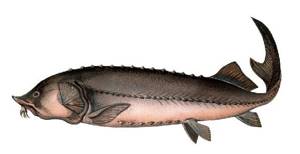
Beluga is the largest freshwater fish. There is information that even at the beginning of the last century, individuals weighing up to 2 tons were caught. However, predatory fishing and regulation of river flows have led to a catastrophic decline not only in the size of individual fish, but also in the size of the entire population as a whole.
The latest documentary evidence of the capture of belugas weighing about 1 ton dates back to the 80s of the 20th century. Apparently, now individuals larger than 200-300 kg are not found in our reservoirs. Beluga is a predator that feeds on other fish and some shellfish. Depending on the course of spring processes, spawning occurs in April-May. Adult belugas switch almost entirely to feeding on fish, sometimes eating shellfish.
Beluga does not have particularly fatty meat, but the calorie content remains at an average level - 150 kcal. Fish is rich in protein compounds and other beneficial microelements. In general, beluga helps:
- Improve mental performance.
- Reduce inflammatory effects.
- Prevents the formation of stones.
The taste of the fish is tough, and some of the species have a characteristic creamy tint.
Siberian sturgeon
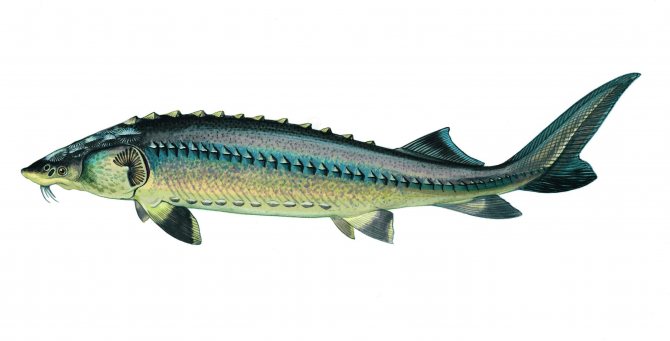
The Siberian sturgeon lives in the rivers of the Arctic Ocean basin (Ob, Yenisei, Lena, Kolyma, Yana, Indigirka) and Baikal. Reaches a weight of up to 200 kg with a length of 2 m. One of the slowest growing representatives of the sturgeon. Puberty occurs quite late. Spawning occurs in May-June, it is conservative in the choice of spawning sites, climbing the rivers to the same places every year.
The diet includes any animal food that he can find. Interestingly, while slowly gaining weight in the harsh conditions of northern rivers, the Siberian sturgeon grows very quickly in a favorable environment. Thanks to this quality, it has become widely used for breeding in pond farms, where it grows 5-6 times faster than in the wild.
The energy value of sturgeon is one of the highest - almost 170 kcal. The variety of varieties allows fish connoisseurs to prepare delicious dishes for every taste. At the same time, the useful properties of the type in question are also wide.
Here are just some examples of the positive impact on human health:
- Improving the functioning of the gastrointestinal tract.
- Getting a huge number of vitamins and minerals.
- Boosting immunity.
Glutamic acid gives sturgeon its excellent taste. The meat turns out juicy, like poultry or pork. However, you need to be careful when cooking. Otherwise, you can ruin everything good that is in the sturgeon.
Kaluga

Kaluga is endemic to the Amur basin. The second largest representative of the sturgeon, after the beluga. It reaches a weight of up to 1 ton and a length of up to 6 m. In all likelihood, overfishing has led to the fact that such giants are no longer found today. One form of kaluga constantly lives in the Amur, the other feeds in the Amur estuary, rising into the river only to spawn. Kaluga spawns in May-July; between spawnings the fish “rest” for 4-5 years. A typical predator, the main source of nutrition for adults is fish. Young kaluga fish begin to feed on fry already in their second year.
In terms of its properties, kaluga is a real predator. But, unfortunately, the conservation of this species is under threat due to unscrupulous human activities. The fish meat is practically boneless, so this species can be used almost entirely. During cooking, kaluga almost does not lose its mass. In many ways, this is why the breed took the path of extinction.
Among the beneficial microelements contained in fish, it is worth highlighting iodine, Omega-3, and easily digestible fats.
Sterlet

The smallest representative of sturgeon. Sometimes there are individuals up to 15 kg, but more often the average weight is 1-3 kg. Distributed very widely, but unevenly. Most numerous in the Volga basin. Restoration efforts have led to sterlet stocks gradually increasing in many water bodies.
It reaches sexual maturity faster than other sturgeon representatives. Spawning occurs in May on a pebble bottom. Characterized by the fact that it never leaves freshwater bodies of water. It feeds mainly on mollusks and invertebrates, and can eat juveniles of other fish species.
Depending on the type, the energy value of sterlet meat may differ. For example, in European sterlet it may not exceed 100 kcal. Whereas the Siberian variety has more than 300 kcal. The product is rich in proteins and amino acids, which gives it special value. At the same time, the amount of vitamins and minerals is also high.
The culinary properties of sterlet fully correspond to its high cost. It can be prepared in any form, and the number of dishes can amaze the imagination.
Stellate sturgeon
It is well distinguished from other sturgeons by its very elongated snout, long narrow body and the contrast between light scales and darker body. Lives in the Caspian and Azov-Black Sea basins. In our waters it reaches a weight of up to 10 kg, although cases of catching 80-kg individuals are known.
A typical migratory fish, it feeds in the seas and rises to rivers to spawn, although without rising high enough. Spawning begins in May. The main population is maintained by fish factories that release juveniles into the wild. Not so long ago it was one of the main commercial species of sturgeon; 15 years ago its fishing was completely prohibited in all seas.
From a culinary point of view, stellate sturgeon has excellent taste and external qualities. The delicate and juicy taste goes well with the unusual elongated shape of the fish. Additionally, it is worth saying that the meat has a faint taste of iodine.
The calorie content of the type in question is 160 kcal. Stellate sturgeon has acquired the greatest value due to its Omega-3 and Omega-6 content, as well as collagen.
Thorn
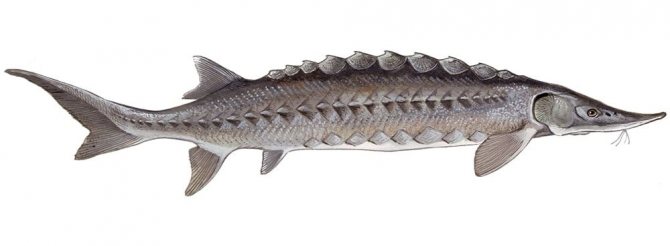
A greatly reduced species. The most resilient group survived only in the Caspian Sea. Very rare in the Azov and Black Seas. It is a semi-anadromous species, winters and spawns in rivers, and feeds in the sea. Reaches a weight of up to 30 kg; now, apparently, such individuals are no longer found. The appearance is characteristic of sturgeons. Easily crosses with other sturgeon species.
The thorn is also listed in the Red Book, like Kaluga. Therefore, we can only talk about its culinary advantages in theory. The energy value of meat is slightly above average - 165 kcal. Yes, it's a fatty fish. But the presence of fatty acids and Omega-3 in its composition allows you to regulate cholesterol levels in the body.
The taste of the spike is sour, but in this case this is a plus. Another advantage of its meat is its low bone content. Therefore, you can eat almost all of the meat.
Russian sturgeon
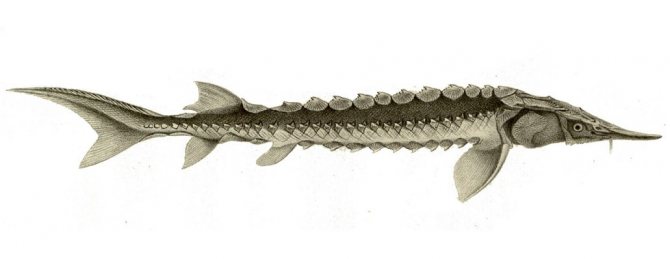
Lives in the Azov, Black and Caspian seas. The main river for spawning is the Volga, where it rises to Volgograd. It also spawns in the Don, Ural, Terek, and Kuban. After this, it rolls off to the seas to feed. It is distinguished by a rounded, relatively short snout. The average weight does not exceed 20-25 kg; individuals up to 115 kg have been recorded. The basis of nutrition in the seas are worms and mollusks; in deltas and rivers it actively eats fish.
shovelnose

The shovelnose is a native of North America. A relatively small fish, a little more than a meter long and weighing up to 5 kg. The name contains its main difference - a wide, long and flat snout. A close relative lives in Kyrgyzstan and Turkmenistan - the false pathos.
Bester

In order to increase the productivity of commercial fish farming, different species of sturgeon are often crossed. One of these hybrids is bester, obtained by crossing beluga and sterlet. Thanks to breeding work, a hybrid was obtained that combines the large mass of beluga and the short period of puberty of sterlet. This hybrid is grown in commercial farms in many countries. Bester does not reproduce in nature.
The properties of this fish allow you to fully realize the culinary needs of a person. In terms of both taste and beneficial properties of the meat, it is something between beluga and sterlet.
The calorie content of bester is about 150 kcal. During processing, almost all cooking options are used, which only adds value to its meat.
Farmed and wild salmon: are there any differences?
The main source of product exports is farmed salmon, which is bred in Sweden, Norway, Scotland, Finland and a number of other countries. It is especially exported from Norway and Chile. And artificial cultivation is a way out of the situation: the fish is rare and is protected in the waters of some countries.
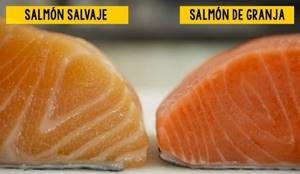
Nobody forbids breeding it, but the technology is quite expensive. In order to get a five-kilogram fish from a 25 cm fry in a year, you need to spend a lot of money. In Russia, farms of this type have not yet become widespread.
Wild fish find food on their own, being in their natural habitat and obtaining food for themselves. Under conditions of artificial breeding, salmon receive a balanced diet. The granules, the composition of which is quite diverse, contain proteins, oils, fish meal, and cereals. The composition of the meat depends on the quality of the feed, so the import and composition of fish products are monitored by the relevant organizations.
Note: In nature, salmon receives a carotenoid from algae and plankton, which colors the meat pink. Under conditions of artificial breeding, the substance astaxatin is added to the food of red fish, but it is not capable of imparting such rich tones to the flesh.
Why is trout valuable?
Trout is a true cosmopolitan species, able to live in fresh and marine waters around the world. Hence its names: freshwater, rainbow, sea. The appearance of the red fish with its bright green scales is not just beautiful. This product is a “concentrate” of useful compounds.
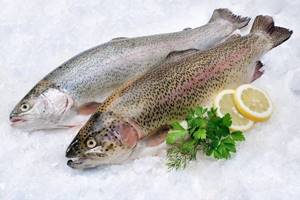
Culinary experts say that trout becomes more tasty when combined with lemon juice, cream sauce, and lime. In ancient cookbooks there are recipes where it is cooked with wine, vegetables and spices or baked in oil. On average, the calorie content of fish ranges from 100 to 200 kcal due to the presence of proteins and fats in the composition.
List of fish
- Noble salmon . This fish is most often called salmon. This is a large fish, reaching a length of up to one and a half meters. Its weight is up to 40 kilograms. Far Eastern salmon has a silvery color, only on the sides, just above the midline, there are several dark spots that form the letter “X”. The sides of the scales have a bluish tint.
- Pink salmon. It is very easy to distinguish it from other representatives of this genus by its small silver scales and the presence of many spots near the tail. During spawning, it changes color and appearance. Females become darker in color, and males develop teeth and a hump on their back. The length of the fish is no more than seventy centimeters. Lives in the Pacific and Atlantic oceans. The caviar is large, maybe 8 centimeters in diameter. After spawning, she dies.
- Chum salmon. She is the most famous among fish. It is distinguished by a silver color without spots. During the spawning period, the color changes to dark. It is found in the Pacific Ocean, and goes to the upper reaches of Siberian rivers to reproduce. There are two types of this fish: autumn (its length is 1 meter) and summer (length - no more than eighty centimeters).
- Red salmon. It is found in the Pacific Ocean, however, it is not very popular in Russia, since fishing is carried out off the coast of Asia and Alaska. The fish is distinguished by a significant number of gill eggs and a bright scarlet hue of meat. There are two species that are associated with the spawning season: spring, summer or autumn.
- Coho salmon. It is also found in the Pacific Ocean, and goes to the waters of North America and Asia to reproduce. The fish has a silvery color, which is why it is called silver salmon. Its length is no more than sixty centimeters, however, you can find individuals whose length can be eighty centimeters. During reproduction, it changes color to bright crimson.
- Chinook salmon. The most valuable and largest species of the salmon family. The fish can weigh up to fifty kilograms, with a body length of ninety centimeters. It is distinguished by pronounced gill stripes, of which it has at least fifteen pieces. It is found off the coast of North America, but comes to the shores of the Far East to breed. It has healthy red meat.
- Brown trout. Found in the Baltic, Black and White Seas. It is also called taimen. Its length is no more than half a meter, and its weight is no more than five kilograms. Brown trout has tasty and nutritious meat. It breeds in the upper reaches of rivers and in fresh water bodies.
- Whitefish. This is a not very large representative of the family, which is found in both salt and fresh water bodies. It is distinguished by silvery scales and dark fins. Whitefish are divided into subspecies that are no different in appearance. Its meat is white.
- Nelma. It belongs to the whitefish family, but unlike other representatives of this subspecies, it can have a length of up to one and a half meters, with a weight of about thirty kilograms. It loves fresh water bodies and is most often found in northern rivers.
- Taimen. This fish is divided into ordinary, Sakhalin, Korean and Danube taimen. The difference is in appearance, this is due to the habitat. The common taimen differs from the Danube taimen in the number of stripes on the gills. The Sakhalin can be up to a meter long and weigh thirty kilograms.
- Lenok. It is distinguished by its black color with a yellow tint. His calf is small. The appearance of lenok is similar to whitefish. Lives in fresh water bodies.
- Trout. Found in fresh lakes such as Onega and Ladoga. Found in Karelia and in the White Sea and Baltic basins. Depending on their habitat, they distinguish between brook and lake trout. Loves fresh, clean water. At the same time, it has an unusual color. It has tasty meat, which is why it is in high demand among fishermen. Can be bred in both natural and artificial reservoirs.
- Ishkhan. Found in Lake Sevan, and translated as “prince”. Usually it is silver in color, but during the spawning period it becomes black, with bright scarlet spots on the body. Some individuals can weigh up to fifteen kilograms, however, the average size is thirty centimeters in length, weighing no more than a kilogram.
The salmon family has a large variety of fish, valued for their excellent taste. All of them are in demand among amateur fishermen and athletes.
Raising rainbow trout
European fisheries have begun breeding rainbow trout as the most valuable food product in terms of its nutritional components. Red fish mollies are placed in special water gardens and then transferred to small lakes. Here the goldfish reaches its maximum size and is caught for sale.
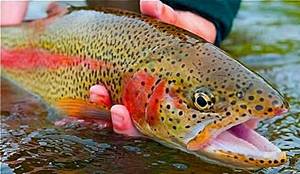
Paid fishing is allowed on the banks of such reservoirs, and lovers of this fishery flock here. Farms in Denmark, Italy and France are at the forefront of trout farming. This is where the main lovers of red fish meat live. In Russia they have just begun to seriously master this craft.
Note: The tastiest part of salmon fish is the fillet. And the heads and tails make excellent fish soup or fish broth, to which you can add your favorite ingredients. For example, fish solyanka has an excellent taste.
How to make the right choice when purchasing
Most often, red fish is sold in vacuum packaging. It is dense and due to the lack of air, food substances do not oxidize for a long time, and the tightness allows you to protect the contents from microbes. That is why many buyers conclude that the product can be stored indefinitely in such packaging.
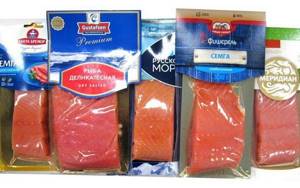
In this form, the fish really retains its valuable nutritional qualities. But when buying various types of red fish packaged in this way, you should not miss a number of important points:
- check the integrity and tightness of the packaging;
- make sure that there are no air bubbles under the film and that it fits tightly to the product;
- the packaging must have a stamp with the production date or a printed label, which is less reliable, since it can be re-glued again and again;
- pay attention to the appearance of the fish, whose eyes are bulging, the pupils are black, and the body is covered with shiny scales.
Note: If the surface of the scales or slices is covered with whitish mucus, then the product is stale and is not particularly fresh. Expired products in vacuum packaging cause the most severe poisoning.
Types of red fish

Experts distinguish 3 main groups of red fish:
- Sturgeon.
- Salmonids.
- Salmon white or pink.
The first group includes fish species common in the Black, Azov and Caspian Seas, as well as those inhabiting rivers:
- Stellate sturgeon.
- Beluga.
- Bester.
- Russian, Siberian, Danube and Amur sturgeon.
- Thorn.
- Sterlet.
The second group includes fish that live in the White Sea, the Baltic Sea, and the Pacific Ocean. This group includes:
- Salmon.
- Pink salmon.
- Sockeye salmon
- Simu.
- Ketu.
- Chinook salmon.
- Sucker.
- Salmon.
- Kunju.
- Rainbow or river trout, etc.
The color of the meat and caviar of these fish is close to red or orange, just like its mating plumage.
Salmon fish species that have white flesh include:
- Belorybitsa.
- Taimen.
- Nelma.
- Coho salmon, etc.
According to many experts, this is an extremely incorrect interpretation of this issue, since salmon should not be classified as red fish. Despite these disagreements, it still makes sense to pay attention to some groups of fish that are commonly called red. Our ancestors called the fish “red” not only because its meat is red, but also because it is especially tasty and beautiful.
red fish
Shelf life of seafood product
Since the product is perishable, the expiration date must be checked. Packaged fish should be on the top shelf of the refrigerator. If it is cold smoked fish, then it will last up to 2 months; if it is hot smoked, it will last no more than a month.
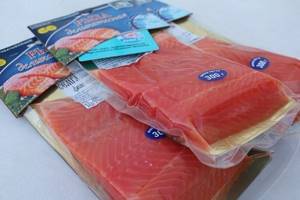
If the package is opened, the product must be consumed within 2 days. A closed vacuum film does not protect against spoilage if the cuts are stored at room temperature.
Contraindications
Fish is high in calories and high in fat, so it is not recommended:
- women during pregnancy and breastfeeding;
- people prone to obesity;
- for problems with the gastrointestinal tract;
- if the liver suffers from chronic diseases;
- for allergic reactions to fish products.
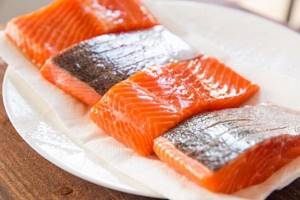
People have been catching red fish since ancient times; it has always helped to survive and given strength.
This is not only salmon and trout; chum salmon and pink salmon were the source of food. 300 g of sea fish, eaten once a week, nourishes the body with omega fatty acids, gives vigor and energy, and supports the immune system.
This is not a bitter medicine, but a delicious gourmet product that helps a person withstand everyday stress and look great at the same time.
Salmon fish species
Salmon fish have a body covered with dense silvery scales; there are no scales on the head. The dorsal fin is short, located in the middle part of the body. Behind the dorsal fin there is a soft adipose fin, similar to an earlobe. Among the salmon there are migratory fish (chum salmon, salmon, salmon, etc.) and freshwater fish (whitefish, trout). All salmon spawn in fresh water. Salmon meat is tender, fatty and low-boned; in typical salmon it is colored pink or red.
The entire salmon family can be divided into salmon itself, white fish and nelma, whitefish, Far Eastern salmon and other salmon.
- Northern salmon (salmon) (lat. Salmonidae) has tasty and nutritious meat, rich in vitamins. This is one of the most valuable types of salmon. Baltic salmon are of lower quality than northern salmon. The average weight of northern salmon is 4-10 kg, Kura salmon – 13 kg.
- Whitefish (lat. Coregonus) of European regions - Nevsky, Volkhovsky, Ladoga, Svirsky, Onega, Ozerny, etc.; Siberian-Pechersk whitefish - pyzhyan (Siberian whitefish), muksun, whitefish, peled (cheese), omul, tugun (Sosvinsky herring), vendace. Some salmon caught in the Siberian region are called Siberian white salmon for their tasty white meat.
- Pink salmon (lat. - Oncorhynchus gorbuscha) lives in the northern part of the Pacific Ocean. Unlike Atlantic salmon and rainbow trout, pink salmon is wild salmon. Sea pink salmon is silver in color and has dense, dark pink meat. After entering the river, pink salmon takes on “nuptial plumage” - the body color changes to greenish-brown, stripes and spots appear, and the meat becomes white. Males develop a hump, their teeth become enlarged and curved, and their nose curves downward in a hook. River (spawning) pink salmon is called “catfish”.
- Chum salmon (lat. - Oncorhynchus keta) is a very important fishery target, the second largest species of Far Eastern salmon. Widely distributed throughout the North Pacific Ocean. Sea chum salmon are silvery in color (serebryanka), in the river they are brownish-green, with dark purple or dark crimson stripes.
- Sockeye salmon (lat. Oncorhynchus nerka) has an average weight of 2-3.5 kg; the scales of sockeye salmon are larger than those of pink salmon. In terms of fat content of meat (8-11%), sockeye salmon is second only to chinook salmon. During spawning, the surface of the fish turns red. The meat of sockeye salmon caught at sea is bright red in color, and during spawning its meat turns white.
- Coho salmon (lat. Oncorhynchus kisutch) has a thick head and a wide base of the caudal fin. Average weight is about 3.5 kg, fat content 6-9%. Far Eastern salmon are sold chilled, frozen, salted, and smoked. Almost all are used for the production of canned food. These salmon, mainly chum salmon and pink salmon, produce valuable caviar of a bright orange color.
Source: https://antario-group.com/lososevye-porody-ryb
